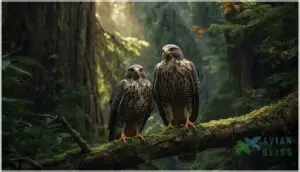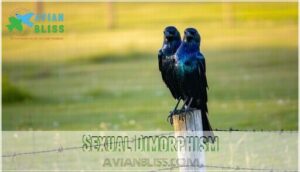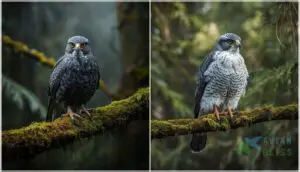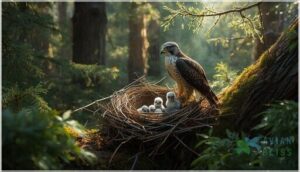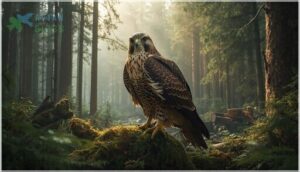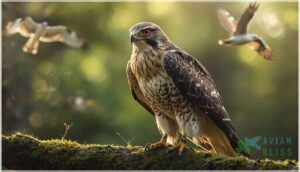This site is supported by our readers. We may earn a commission, at no cost to you, if you purchase through links.

Most birds shy away from dense woods, but the goshawk thrives there, weaving through the tangled canopy where few predators dare to hunt. Its sharp features and bold white eyebrows mark it as a master of stealth and speed.
If you want to understand how this bird rules its territory—what sets it apart, how it survives, and why its future matters—the details tell a compelling story.
Table Of Contents
- Northern Goshawk: Identification and Physical Characteristics
- Habitat and Range of The Northern Goshawk
- Northern Goshawk Hunting Techniques and Diet
- Nesting Behavior and Reproduction of Northern Goshawks
- Conservation Status and Threats to Northern Goshawks
- Distinguishing Northern Goshawks From Similar Species
- Ecological Role and Importance of Northern Goshawks
- Frequently Asked Questions (FAQs)
- Where can I find Northern Goshawk?
- How can you tell a Goshawk from a Cooper’s hawk?
- Are Northern Goshawks aggressive?
- What is the difference between a Northern Goshawk and a Cooper’s hawk?
- How do northern goshawks interact with human environments?
- What sounds or calls do northern goshawks make?
- How long do northern goshawks typically live?
- Are there any cultural or historical associations with goshawks?
- Do northern goshawks migrate seasonally?
- How long do northern goshawks live in the wild?
- Conclusion
Northern Goshawk: Identification and Physical Characteristics
If you want to spot a Northern Goshawk, it helps to know what sets them apart. These hawks have some features you can’t miss once you know what to look for.
Let’s break down the key traits that make this bird unique.
Size and Measurements
You’ll notice Northern Goshawk measurements reveal striking sexual dimorphism and subspecies variation. Females often outsize males, reaching 24 inches in length and up to 3 pounds. Males average 22 inches and 2.4 pounds. Wingspan ratios range from 38.5 to 45 inches. Weight ranges and precise measurement techniques help distinguish individuals.
These goshawks are often found in old-growth forests with dense canopies. These goshawk measurements show how body size is suited to forest hunting across regions.
Plumage and Coloration
Body size sets the stage, but plumage brings the Northern Goshawk’s story to life. Adult plumage is a patchwork of slate-gray backs and bold white eyebrows, with red eyes that catch sunlight. Juvenile coloration leans brown, streaked and buff, blending into forest shadows. Over several years, molting patterns shift these birds toward their mature look. They’re considered true hawks by ornithologists.
Subspecies variation means feather markings and brightness can change, depending on where your goshawk calls home.
- Slate-gray adult plumage
- Bold white superciliary stripe
- Brown juvenile coloration
- Molting patterns reveal age
Sexual Dimorphism
Plumage is only part of the story—size disparities set northern goshawks apart. Sexual dimorphism is striking: females are bigger, broader, and up to 25% heavier than males. This difference shapes hunting roles, with females tackling larger prey and males chasing smaller birds.
Vocal differences matter too. These traits offer evolutionary advantages, though studies show dimorphism decline in some northern populations. Adult male and female plumage remain distinct.
Subspecies Variations
Size differences between male and female goshawks are just the beginning—subspecies add another layer. Across North America, you’ll find Coastal Goshawks (A. g. laingi) and interior populations (A. g. atricapillus) with distinct morphological traits and plumage. Their geographic distribution shapes everything from body size to coloration.
- Coastal Goshawks are smaller, darker, and more secretive
- Hybridization zones blur some identifying characteristics
- Genetic differentiation drives unique conservation status for each population
Distinctive Features (Eyes, Eyebrows)
When you scan a Northern Goshawk, the first thing that grabs your attention is the sharp contrast between its deep red eye color and bold white eyebrow. These physical characteristics aren’t just striking—they’re essential for Northern Goshawk identification. The iris coloration shifts from bright yellow in juveniles to rich red as adults, signaling maturity and breeding readiness. The supercilium, or white eyebrow, stands out against a dark crown, acting almost like built-in sunglasses to cut glare.
Ocular adaptations, including large eyes and rapid pupil changes, help these hawks hunt in dim forest light. Their facial patterns—black crown, white eyebrow, and cheek patch—aid recognition and communication.
- Red iris coloration in adults
- Thick, white supercilium function
- Distinctive facial patterns for identification
- Specialized ocular adaptations for forest hunting
- High visual acuity for tracking prey
Habitat and Range of The Northern Goshawk
Northern Goshawks need specific habitats to thrive, and their range stretches across many regions. Where they live and how they move can tell you a lot about their survival.
Let’s look at the types of places these hawks call home.
Preferred Forest Types
Ever wonder where a Northern Goshawk feels most at home? These raptors favor mature forests with dense canopy conditions, weaving through woodland habitat rich in mixed conifer and aspen.
You’ll spot their nests in stands over 100 years old, where forest management keeps plenty of large trees standing. Regional associations show a clear preference for forests offering cover, prey, and open flight space.
Global Distribution
Across the Holarctic Range, Northern Goshawks show impressive geographic distribution. You’ll find them weaving through forests from Alaska and Newfoundland to Japan and Scandinavia. Subspecies variation shapes their presence, with outlier populations in Mexico and isolated islands.
Seasonal movement is limited, but vagrants sometimes appear far afield. Population trends shift locally, yet global coverage remains vast.
North American Population Concentrations
Did you know Alaska alone bolsters nearly a third of North America’s Northern Goshawk population? When you look at regional densities, these raptors favor:
- Boreal forests of Alaska and northern Canada (stable Habitat Occupancy)
- Western mountain ranges like the Rockies and Sierra Nevada (key Conservation Hotspots)
- Great Lakes and northeastern forests (sparse but locally increasing)
Population trends show declines where old forests vanish, making range expansion and conservation status real concerns for their future geographic distribution.
Seasonal Migration Patterns
Consider this: Northern Goshawks don’t follow a predictable migration calendar. Instead, their movement is shaped by irruptive migration—triggered by prey declines, especially snowshoe hares and grouse. Some stay put, but others travel hundreds of kilometers, mostly from northern forests to southern ranges.
Juveniles are the most likely to disperse. These regional patterns make monitoring trends and understanding raptor migration essential for grasping their shifting geographic distribution.
Specific Habitat Requirements in Nevada
What sets Northern Goshawk habitat in Nevada apart is the elevation range—these raptors favor forested montane regions from 1,800 to 3,200 meters. You’ll notice their preference for old-growth forest structure, especially Jeffrey pine and aspen stands with dense canopy.
Nesting sites cluster on gentle north-facing slopes near water, while foraging areas weave through mature forest and meadow edges.
Management impacts, like logging, can sharply reduce occupancy and disrupt forest ecosystems.
Northern Goshawk Hunting Techniques and Diet
Northern goshawks are skilled hunters with a wide range of techniques and food choices. If you’re curious about what they eat and how they catch their prey, you’re in the right place.
Here’s what you need to know about their hunting habits and diet.
Primary Prey Species
Every forest tells its own story, and the Northern Goshawk’s diet reveals much about its surroundings. Your understanding of their prey diversity grows when you see how squirrel predation, avian dominance, and lagomorph importance shift with regional variation.
For example, the typical Northern Goshawk diet features:
- Red squirrels and chipmunks in western forests
- Grouse, crows, and woodpeckers in mixed woods
- Snowshoe hares and cottontails where lagomorphs are abundant
Their menu adapts as prey species change with season and habitat.
Hunting Strategies and Success Rates
When you look at the Northern Goshawk’s hunting techniques, you’ll notice how perch hunting gives them an edge—nearly half their hunts start from a quiet perch, followed by a rapid ambush. Their chase dynamics are striking, with sharp turns and bursts of speed through tangled branches.
Hunting efficiency varies: in mature forests, success rates reach up to 30%, while dense cover can lower them. Seasonal variation matters too, with more frequent hunts during breeding. Their strategies adapt, matching prey species and habitat to optimize results.
Adaptations for Forest Hunting
After watching the goshawk’s hunt, you’ll appreciate how its Wing Morphology and Sensory Specializations set it apart. Broad wings and a long tail help it weave through the forest canopy, making quick turns in dense woodland habitat.
Keen eyesight lets it spot prey, even in patchy light. Silent flight and adaptive Hunting Behavior—like waiting quietly, then launching a rapid ambush—show why this raptor’s Maneuverability and Hunting techniques are perfectly tuned for forest hunting strategies.
Daily Food Requirements
You might wonder how a Northern Goshawk keeps its edge. Their daily food intake—about 120–150 grams of prey biomass—matches high caloric needs and sharpens their hunting instincts. Seasonal variation means diet shifts with prey, and consumption efficiency stays near 79%. Foraging duration averages 90–120 minutes.
Here’s what shapes their feeding behavior:
- Prey biomass consumed
- Caloric needs met
- Seasonal variation in diet
- Efficient foraging duration
Prey Caching Behavior
Think of a Northern Goshawk as a strategist—always planning for tomorrow’s meal. Cache site selection is precise; food is wedged between branches or near the trunk to keep prey safe from scavengers.
Cache duration often matches the nestling stage, supporting breeding success. Seasonal caching variation means more frequent storing in spring and summer when feeding behavior intensifies.
Prey biomass in caches, including red squirrels and birds, provides steady nutrition. This clever approach shapes goshawk diet and prey access year-round.
Nesting Behavior and Reproduction of Northern Goshawks
Northern goshawks have a unique way of raising their young, shaped by the forests they call home. If you’re curious how these birds build nests, care for eggs, and raise chicks, you’ll find the answers just ahead.
Let’s look at the key stages in their nesting and reproductive cycle.
Nest Construction and Placement
Ever wondered how a goshawk chooses its nest site? Their nesting behavior is all about precision. You’ll see nests expertly built from sticks and fresh greenery, tucked high in mature trees with dense canopy. They favor spots near forest clearings or water, and reuse sturdy nests year after year. Here’s what matters most:
- Nest Materials: sticks, bark, evergreens
- Tree Selection: tall, mature, closed canopy
- Nest Orientation: trunk-supported branches
- Nest Reuse: reinforced over seasons
Breeding Season and Courtship Displays
As spring unfolds, Northern Goshawks launch into courtship with bold aerial displays and distinct courtship vocalizations. Males soar, dive, and flaunt their undertail feathers, all part of their territorial displays to attract a mate.
Pair formation often involves complex age dynamics, with older males sometimes pairing with younger females. These rituals play a key role in breeding success, shaping avian reproduction and the nesting behavior you’ll see each year.
Egg Laying and Incubation
Curious how a fierce hunter becomes a careful parent? During nesting, Northern Goshawks lay a clutch of bluish white eggs, usually 2–4 per nest. The incubation period stretches 28–38 days, with both parents sharing duties. Females handle most brooding, while males supply food. Nest success depends on steady warmth and protection, especially in cold, wet springs.
- Clutch Size averages 2.7 eggs
- Incubation Period: 28–38 days
- Egg Color: bluish white
- Parental Roles: female broods, male feeds
Chick Development and Fledging
Witnessing juvenile Northern Goshawks transform is like watching a blueprint come to life. Nestling growth is rapid—chicks gain mass quickly and branch out at 34 days. Fledging success hinges on food and weather; most nestlings leave the nest by 42 days.
Post-fledging dependency lasts weeks, with behavioral achievements like first flights and branching marking progress. Influencing factors, such as prey and temperature, shape juvenile bird development and nesting habits.
| Stage | Days Old | Key Achievement |
|---|---|---|
| Nestling | 1–14 | Down growth, eyes open |
| Branching | 34–36 | Move to branches |
| Fledging | 35–42 | First flights |
Parental Care and Division of Labor
Think of Northern Goshawk parenting as a well-rehearsed duet. You’ll notice clear sex-specific roles shaping goshawk nesting habits and breeding behavior. Here’s how it works:
- The female leads with nest attendance, brooding, and defense.
- The male focuses on food provisioning, hunting almost nonstop.
- Parental flexibility kicks in—roles adapt to food supply and chick needs.
- Goshawk parental care is adaptable, with both parents adjusting their efforts.
- This division of labor drives reproductive success, showing how avian reproduction thrives on teamwork and adaptability.
Conservation Status and Threats to Northern Goshawks
Regarding Northern Goshawks, their future depends on more than just luck. There are several key factors shaping their survival and status today.
Here’s what you need to know about the main issues and efforts affecting these birds.
Current Population Estimates
Across their vast geographic distribution, Northern Goshawks show striking differences in population densities. Global Abundance estimates reach over one million birds, while Regional Densities in North America range from dense forests in Alaska to just a handful in Pennsylvania.
Population Trends reveal:
- Around 420,000 individuals in North America.
- Over 3,000 documented breeding areas in the continental U.S.
- Conservation Designations and Monitoring Efforts highlight sharp declines in some regions, driving targeted Conservation Efforts to safeguard remaining populations.
Historical Population Trends
If you look at Goshawk Population Trends, you’ll spot dramatic past range reductions. In the 1800s, deforestation and persecution nearly wiped out these birds in parts of North America and Europe. Mid-century recovery followed as forests regrew, but Western decline causes—like habitat fragmentation—persisted.
European shifts saw changes in body size and survival. Modern trends show overall stability, yet regional differences mean Conservation Status of Birds depends on local Conservation Efforts and Forest Management Practices.
Habitat Loss and Deforestation Impacts
After seeing how population trends shift, you’ll notice habitat loss is the main driver. Forest fragmentation carves up the landscape, leaving fewer places for goshawks to hunt and nest. Prey depletion follows as forest edges expand and mature stands shrink.
Nesting disruption rises when timber harvests clear large swaths, forcing birds to relocate. Fire impacts add another layer—some fires remove essential cover, while others open up foraging.
Climate change now pushes these birds to adapt faster than ever. Conservation status depends on smart forest management and protecting continuous habitat patches.
Legal Protection Status
Habitat management laws and forest management practices shape the Goshawk Conservation Status more than you might expect. After habitat loss, legal protection steps in—sometimes strong, sometimes patchy. Globally, the IUCN status for Northern Goshawks sits at “Least Concern,” but regional rules vary. The Migratory Bird Act in the U.S. bans harm or possession without a permit. State-level protections go further: Michigan lists the goshawk as “Threatened,” while Pennsylvania calls it “Endangered.” Across Europe, the EU Birds Directive and national laws shield nests and breeding sites. Here’s what you’ll find:
- Global IUCN status: Least Concern.
- U.S. Migratory Bird Act and state-level protections.
- EU Birds Directive and strict habitat management laws.
Conservation Efforts and Management Strategies
If you’re curious about how Northern Goshawk conservation works in practice, it’s all about blending science and strategy. Forest management practices focus on habitat restoration and adaptive management, while monitoring initiatives track population changes. Policy integration ensures recovery programs stay on course. Here’s how it looks in the field:
- Restoring mature forest stands and buffers for nesting
- Using bioacoustic recorders for annual population monitoring
- Coordinating multi-agency recovery programs and conservation assessment
These steps maintain the goshawk conservation status and strengthen conservation notes for future generations.
Distinguishing Northern Goshawks From Similar Species
Telling Northern Goshawks apart from other raptors can be tricky, especially in the field. You’ll want to pay close attention to their size, markings, and flight style.
Here’s how they compare to a few species you’re likely to encounter.
Comparison With Cooper’s Hawks
Ever wondered how to tell a Northern Goshawk from a Cooper’s Hawk when both zip through the forest? Start with size comparison—goshawks are noticeably larger and sturdier, with bold physical characteristics like a striking white eyebrow and wedge-shaped tail. Cooper’s Hawks, more common, show sharper contrast on their head and reddish barring below.
Regarding hunting behavior, goshawks chase prey farther and select denser habitat overlap for nesting. Here’s a quick species comparison:
| Feature | Northern Goshawk | Cooper’s Hawk |
|---|---|---|
| Size | Large, sturdier | Medium, slender |
| Eyebrow/Plumage | Bold white, gray bars | Weak, reddish bars |
| Nesting Differences | High, dense canopy | Lower, open woods |
Differences From Red-shouldered Hawks
For bird identification, distinguishing a Northern Goshawk from a Red-shouldered Hawk means looking closely at morphological contrasts and habitat distinctions. Goshawks are larger, with thick legs and a bold white eyebrow. Red-shouldered Hawks show reddish-orange breasts and banded tails.
Compare their hunting differences and flight patterns—goshawks dash through dense forests, while Red-shouldered Hawks glide above wetlands. Consider these features:
- Bulkier body
- Slate-gray upperparts
- White superciliary line
- Strongly banded tail
- Forest versus wetland preference
Contrast With Peregrine Falcons
Consider this: the Northern Goshawk (Accipiter gentilis) weaving through forest shadows, while a Peregrine Falcon slices the sky above city towers. Their Flight Mechanics set them apart—Goshawks have broad wings for woodland agility; Peregrines, pointed wings for high-speed dives.
Habitat Overlap is rare, with Peregrines thriving in urban adaptation. Hunting Styles differ too: Goshawks ambush prey, Peregrines strike midair.
Conservation Divergence shows Peregrines rebounding in cities, while Goshawks need intact forests. Two raptor species, worlds apart.
Distinctions From Gyrfalcons
When you compare Northern Goshawks (Accipiter gentilis) to Gyrfalcons, the differences leap out. Gyrfalcons are nearly twice as heavy, with pointed wings for tundra pursuits, while Goshawks weave through forests using rounded wings. Their eyes, plumage, and hunting tactics set them apart. Here’s how these raptor species differ:
- Morphological Differences
- Habitat Overlap
- Hunting Strategies
- Breeding Contrasts
- Conservation Pressures
These features help you identify similar species with confidence.
Key Identification Features in Flight
Spotting a Northern Goshawk in flight is like reading the forest’s signature. Your best clues come from their distinctive wing shape and deep-chested silhouette. Notice how their long tail with alternating dark and pale bands trails behind, and their powerful flight patterns cut through the trees. For accurate Accipiter identification, focus on these four features:
- Broad, rounded wings with a curved trailing edge
- Bold white eyebrow in plumage details
- Steady, deliberate wingbeats
- Long tail markings, smoothly extending
Ecological Role and Importance of Northern Goshawks
Northern Goshawks play a key part in keeping forests balanced and healthy. Their presence tells you a lot about the land and the creatures living there.
Here’s how these birds shape their world and why they matter.
Predator-Prey Relationships
Through the lens of predator-prey relationships, you’ll see how the northern goshawk’s prey selection and hunting success ripple through the forest. This dominant predator’s diet diversity—ranging from squirrels to grouse—drives a trophic cascade, altering prey abundance and behavior. Goshawk hunting techniques, like rapid tail chases, create shifting predation patterns. The result? Goshawk diet and feeding habits help balance avian and mammalian prey populations, weaving an active web of influence throughout the ecosystem.
| Predator | Prey Type | Impact |
|---|---|---|
| Goshawk | Birds | Controls numbers |
| Goshawk | Mammals | Alters behavior |
| Goshawk | Mixed Diet | Trophic cascade |
Impact on Forest Ecosystems
When you look at northern goshawks, you’re seeing more than a predator—they’re a force weaving order through the forest. By controlling prey populations, these hawks help forests regenerate and boost biodiversity. Their response to disturbance shapes ecosystem resilience, especially after fires or logging. Here’s how goshawks influence their world:
Northern goshawks are more than predators—they weave order through forests, driving regeneration, biodiversity, and resilience after disturbance
- Prey population control keeps herbivores in check.
- Forest regeneration thrives with fewer mammals browsing seedlings.
- Biodiversity impact fosters a richer mix of forest birds.
Indicator Species for Forest Health
Just as goshawks shape forest life, they also act as living gauges for habitat integrity. When you spot an American Goshawk in mature forests, you’re seeing a sign that the habitat and ecology are in balance. Their sensitivity to forest alteration makes them key for population monitoring.
For example, goshawk breeding success signals:
- High canopy closure
- Stable avian species communities
- Effective management applications for conservation
Their presence truly marks a healthy woodland.
Cultural Significance
Just as goshawks measure forest health, they also carry deep meaning for people. Goshawk Symbolism stretches from Old English “gosheafoc” to modern flags and regalia.
Indigenous Traditions honor their feathers and talons for strength and authority. Medieval Falconry history prized their aggression and skill, reserving them for nobility.
Art Representation captures their wildness and mastery. Social Status often rose with a goshawk gift or motif, making these birds more than hunters—they’re woven into stories of power and respect.
Research and Scientific Importance
When you dive into research on Northern Goshawks, you’re exploring a world where genetic mapping shapes taxonomic classification and conservation policy. Scientists use survey methodologies and habitat assessment to monitor:
- Population trends and genetic clusters
- Species identification and avian ecology
- Conservation status of birds in fragmented forests
- Sophisticated research techniques for nest-site study
Every study helps clarify how these raptors weave into forest health.
Frequently Asked Questions (FAQs)
Where can I find Northern Goshawk?
You’ll spot Northern Goshawk in mature coniferous or mixed forests, often at elevations between 1,400 and 2,800 meters.
Search quiet, dense stands in regional hotspots like the Rockies, using patience and stealth for best observing results.
How can you tell a Goshawk from a Cooper’s hawk?
Broad wings, bold white eyebrow, and barrel-chested build set American Goshawk identification apart from Cooper’s Hawk.
Size comparison favors the Goshawk, with slate-gray plumage, deep ruby eyes, and a rounded tail marked by distinct dark bands.
Are Northern Goshawks aggressive?
You’ll notice strong nest defense and urban aggression in this species, especially during breeding season.
Their goshawk behavior includes swooping at intruders and engaging in raptor conflicts over prey competition, making them one of the boldest avian predators.
What is the difference between a Northern Goshawk and a Cooper’s hawk?
When you compare Accipiters, Northern Goshawks stand out for their size, bold white eyebrow, and powerful build. Cooper’s Hawks are slimmer, have a longer tail, less prominent eyebrow, and prefer urban edges. Both excel at hunting birds.
How do northern goshawks interact with human environments?
Like shadows slipping through tangled woods, these hawks rarely settle near people. Urban adaptation is limited; human disturbance and habitat fragmentation often push them away.
Nest defense intensifies, and mortality factors rise, making conservation strategies essential for their survival.
What sounds or calls do northern goshawks make?
You’ll hear rapid “kikikiki” alarm calls, sharp “kek” notes, and wailing “kreeya” cries.
Adult vocalizations defend territory, while juvenile calls beg for food.
Gender differences and call evolution shape these bird vocalizations for dense forests.
How long do northern goshawks typically live?
You might say time is both friend and foe for these raptors. The average lifespan in the wild hovers around 7 to 12 years, but some reach a maximum age of 16, shaped by survival rates and mortality causes.
Are there any cultural or historical associations with goshawks?
Goshawk Symbolism runs deep—these raptors have embodied strength and leadership in Goshawk Mythology, Heraldic Goshawks, and Falconry history.
Northern Goshawks feature in Goshawk Art and Literary Goshawks, often representing nobility, courage, and mastery as a bird of prey.
Do northern goshawks migrate seasonally?
Seasonal migration in these hawks depends on climate impacts and prey scarcity. Some stay year-round, while others shift habitats through altitudinal or irruptive migration.
Migration triggers include changing food supply, shaping bird migration patterns and distribution of goshawks.
How long do northern goshawks live in the wild?
If you gave a northern goshawk a wristwatch, it’d tick for up to 11 years in the wild. Some reach a Maximum Age of over 17 years, shaped by Juvenile Survival, Adult Longevity, and Influencing Factors like habitat and avian development.
Conclusion
Looking ahead, the northern goshawk’s fate mirrors the forests it calls home. If you ever spot its shadow gliding between trunks, remember: each sighting is a sign of a healthy ecosystem.
This raptor isn’t just a skilled hunter—it’s a living measure of balance and resilience. Understanding its habits and needs gives you a window into the hidden life of wild places.
The story of the goshawk continues wherever forests remain untamed, and your curiosity helps keep it alive.
- https://wgfd.wyo.gov/media/1372/download?inline
- https://extapps.dec.ny.gov/fs/programs/dfw/SWAP2025/Birds/American%20goshawk.pdf
- https://pmc.ncbi.nlm.nih.gov/articles/PMC11294034/
- https://www.pa.gov/content/dam/copapwp-pagov/en/pgc/documents/wildlife/endangeredandthreatened/documents/northern%20goshawk.pdf
- https://nrm.dfg.ca.gov/FileHandler.ashx?DocumentID=10394

